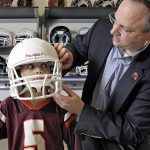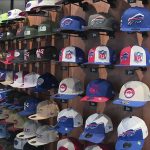S&P Global Ratings revised its debt outlook to stable from negative on Callaway and Topgolf. At the same time, the ratings agency affirmed its ‘B’ issuer credit rating on Callaway and its ‘B-‘ issuer credit rating on Topgolf.
S&P said, “The rating affirmation and outlook revision to stable primarily reflects lower leverage due to significantly higher profitability at Topgolf than we previously expected. Callaway completed its acquisition of Topgolf in March 2021, and since that time Topgolf has significantly outperformed our expectations. Topgolf returned to pre-pandemic levels of same-venue sales quicker than we forecast. But more importantly, the company meaningfully improved its margins compared to pre-pandemic. The margin improvement came from better-operating efficiency through actions such as simplifying food and beverage menus, reducing the number of managerial positions required to run venues, and operating leverage from a higher number of open venues that helped absorb selling, general, and administrative (SG&A) costs. We expect some incremental spending on labor will need to return to get to ideal staffing levels, but believe these margins are largely sustainable. In addition to accelerating its deleveraging path, the better cash generation from higher profitability also reduces the amount of cash that Callaway will have to contribute to funding Topgolf’s venue expansion plans.
“Robust demand for golf equipment is also contributing to rapid deleveraging. Callaway recovered rapidly from the early days of the pandemic when coronavirus-related stay-at-home orders temporarily shut down most golf courses, retailers, and manufacturing facilities. Following the initial shutdowns, the consumer desire for socially distanced outdoor activities drove a remarkable increase in golf participation and equipment sales. While the outsized growth rates have begun to moderate compared to 2020, demand remains robust. Callaway’s golf equipment sales for the first nine months of 2021 were nearly 30 percent higher than the same period in 2019, with third-quarter sales still up more than 35 percent from 2019. According to the National Golf Foundation’s (NGF) summer 2021 survey of golf product attitudes and usage: “When comparing 2021 purchase interest to historical norms and to last year, they remain healthy and suggest the Spring of 2022 will see continued demand close to recent levels in most product categories, while nothing suggests demand will spike or grow.”
“However, the NGF notes risks to golf club demand in 2022, including a decline in consumer confidence potentially caused by the emergence of other coronavirus variants, and the lengthening of golf club purchase cycles. It is also unclear how committed the new golfers that recently entered the sport will be once other entertainment options become more readily available to consumers after the pandemic subsides. In our view, the industry’s ability to retain these new consumers over the longer term will primarily depend on the desirability and value of the sport compared with other entertainment options. Nevertheless, we expect the surge in participation to be a tailwind for the golf industry over the next few years and anticipate both Callaway and Topgolf will likely benefit from the rise in golf participation. Callaway’s customers, such as Dicks Sporting Goods, also appear optimistic on golf demand. Further, channel inventories are currently low, so manufacturers like Callaway will benefit in the near term from sell-in to replenish inventory even if demand wanes more than expected.
“Callaway has improved margin despite supply chain and inflation challenges. Like most other manufacturers, Callaway is experiencing rapid inflation in commodity, transportation, labor, and other input costs. So far it has been able to overcome the higher costs through volume gains and price increases. Its Vietnam facilities were shut down following the emergence of the Delta variant in late summer but have since reopened and the company believes it will not experience any meaningful disruptions to its early 2022 product launches. We expect continued inflation in certain areas through at least the first half of 2022, but we forecast the company will be able to continue to offset much of this pressure through further price increases and higher volumes.
“Topgolf stand-alone continues to rely on funding from Callaway and its REIT partners to grow. At more than 65 open venues, Topgolf has reached a size where aggregate venue profits are more than enough to offset corporate SG&A costs and pre-opening costs for new venues, such that it is now generating significant reported EBITDA: we forecast over $150 million (excluding stock-based compensation) in 2021. Its stand-alone adjusted leverage is still high at about 7.5x because of very high lease obligations, but it has come down considerably from about 9x as of the prior quarter and double-digits before that. We forecast leverage will remain in the 7x area through 2022. While we believe Topgolf would generate positive free cash flow if it stopped building new venues, its aggressive growth plans incorporating at least 10 new venues per year require total capital expenditures in the range of $300 million to $450 million per year. A large portion of this spending is reimbursed by Topgolf’s REIT partners, but the remaining $200 million to $225 million of Capex per year must be funded by its internally generated operating cash flows, revolver borrowings, and contributions from parent Callaway. We believe the consolidated company could generate positive free cash flow including venue growth Capex in 2023, and Topgolf stand-alone could reach positive free cash flow as early as 2024. However, this is a fairly long time horizon. We expect variability in the business’ potential operating results depending upon Topgolf’s performance after the pandemic, the status of U.S. economic activity and employment, and changes in consumer preferences over time. Although Topgolf has a first-mover advantage in creating a unique golf experience, it faces significant competition from alternative out-of-home entertainment options, among other substitutes for consumers’ discretionary leisure and entertainment spending. Its customers may choose lower-priced or alternative venues to socialize that do not involve golfing, eating, or drinking. Economic pressure could amplify this risk if consumers limit their spending on discretionary leisure activities.
“Topgolf’s harvest case mitigates some of the downside risk. If Topgolf does not reach its goal of becoming self-funding by 2024, it may be difficult to maintain the current pace of investment without pressuring Callaway’s free cash flow. Our rating on Callaway relies on its ability to mitigate this risk and the risk of an economic slowdown by enacting Topgolf’s harvest case, which includes halting future venue development before breaking ground and reducing other discretionary Capex, allowing Topgolf to harvest the cash flows from its existing venues. Although it would take 9 to 12 months to work through the near-term spending commitments on its partially built venues, the elimination of growth capital spending and pre-opening expenses beyond this inflection point would likely enable Topgolf to generate positive free cash flow and EBITDA well above its fixed charges.
“We believe Topgolf is strategically important to the combined entity and anticipate Callaway will likely support Topgolf under most foreseeable circumstances. Former Topgolf shareholders own a significant share of the combined entity as a result of the merger and have three board seats, thus they can exert significant influence. Callaway has also made it clear that Topgolf is an important part of the company’s strategy to create an unrivaled golf and entertainment business. The company believes the combination enhances the growth prospects of both entities. Callaway’s willingness to fund the merger with $1.7 billion of its stock and plan to commit significant cash to fund development at Topgolf further demonstrates this commitment. As such, we believe Callaway would provide extraordinary support to Topgolf under the most foreseeable circumstances. Still, Callaway is not providing guarantees to Topgolf’s debt, which raises some doubts about the extent of Callaway’s support in the event Topgolf encounters significant credit stress.
“The stable outlook reflects our forecast for continued revenue and EBITDA growth due to good demand for golf equipment and apparel, as well as revenue from new venues and good cost control at Topgolf. We forecast consolidated lease-adjusted leverage in the high-4x area through 2022.”









